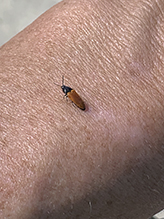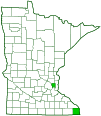blood-winged click beetle
(Ampedus sanguinipennis)
Conservation • Description • Habitat • Ecology • Distribution • Taxonomy
Conservation Status |
|
|||||||
| IUCN Red List | not listed |
|||||||
| NatureServe | NNR - Unranked |
|||||||
| Minnesota | not listed |
|||||||
Description |
||
Blood-winged click beetle is a colorful, small to medium-sized, click beetle. It occurs in the United States from Maine to Georgia, west to Minnesota and Arkansas; in southern Canada from Nova Scotia to Ontario; and there are just a handful of records in the west. They are found in deciduous forests and woodlands. The larvae are found in well-rotted wood, which they feed on. Adults feed on pollen and are found on flowers. Adults are slender-bodied, elongated, and ⅜″ to ½″ (10 to 12 mm) in length. The head is small, triangular, and black. The antennae are long, slender, sawtoothed (serrate), and black. They are inserted close to the eyes. They have eleven segments, including a long basal segment (scape), a short connecting segment (pedicel), and a whip-like section (flagellum) with nine segments (flagellomeres). The second through eighth flagellomeres are triangular. The last segment is oval. The thorax is black and shiny, and it is colored with yellowish-tan (fawn-colored) hairs. It is greatly narrowed and convex in front when viewed from above and is only slightly convex when viewed from the side. The rear angles are sharply backward pointing. The first segment (prothorax) is disproportionately large and is freely articulating, allowing the front part of the body to be moved independently. The hardened wing covers (elytra) are tapered from the base to a broadly convex tip. They are orange with several shallow, longitudinal grooves with deep, dark pits (punctures). There is a single, small, dark spot near the base of each elytron. On the underside, an elongated lobe on the prosternum fits into a groove in the mesosternum, allowing the insect to produce an audible click. This feature gives the insect family its common name. The legs are long and slender. The third segment (femur) and fourth segment (tibia) of each leg is black. The end part (tarsus), corresponding to the foot, is orange and has five segments. |
||
Size |
||
Total length: ⅜″ to ½″ (10 to 12 mm) |
||
Similar Species |
||
Habitat |
||
Deciduous forests and woodlands |
||
Ecology |
||
Season |
||
|
||
Behavior |
||
|
||
Life Cycle |
||
|
||
Larva Food |
||
Rotted wood |
||
Adult Food |
||
Flower pollen |
||
Distribution |
||||
|
Sources |
|||
| 4/26/2023 | ||||
Occurrence |
||||
|
||||
Taxonomy |
|||
Order |
Coleoptera (Beetles) | ||
Suborder |
Polyphaga (Water, Rove, Scarab, Long-horned, Leaf, and Snout Beetles) | ||
Infraorder |
Elateriformia | ||
Superfamily |
Elateroidea (Click, Firefly, and Soldier Beetles) | ||
Family |
Elateridae (click beetles) | ||
Subfamily |
Elaterinae | ||
Tribe |
Ampedini | ||
| Subtribe | Ampedina | ||
Genus |
Ampedus | ||
Synonyms |
|||
Elater sanguinipennis |
|||
Common Names |
|||
blood-winged click beetle |
|||
Glossary
Elytra
The hardened or leathery forewings of beetles used to protect the fragile hindwings, which are used for flying. Singular: elytron.
Femur
On insects and arachnids, the third, largest, most robust segment of the leg, coming immediately before the tibia. On humans, the thigh bone.
Flagellomere
A segment of the whip-like third section of an insect antenna (flagellum).
Pedicel
On plants: the stalk of a single flower in a cluster of flowers. On insects: the second segment of the antennae. On Hymenoptera and Araneae: the narrow stalk connecting the thorax to the abdomen: the preferred term is petiole.
Prothorax
The first (forward) segment of the thorax on an insect, bearing the first pair of legs but not wings.
Scape
In plants: An erect, leafless stalk growing from the rootstock and supporting a flower or a flower cluster. In insects: The basal segment of the antenna.
Tarsus
On insects, the last two to five subdivisions of the leg, attached to the tibia; the foot. On spiders, the last segment of the leg. Plural: tarsi.
Tibia
The fourth segment of an insect leg, after the femur and before the tarsus (foot). The fifth segment of a spider leg or palp. Plural: tibiae.
Visitor Photos |
|||||
Share your photo of this insect. |
|||||
| This button not working for you? Simply email us at info@MinnesotaSeasons.com. Attach one or more photos and, if you like, a caption. |
|||||
Greg Watson |
|||||
This insect landed on my hand while biking the Wagon Wheel Trail in La Crescent. I had my long lens on my camera, so I took the picture with my cell phone. |
 |
||||
MinnesotaSeasons.com Photos |
|||||
|
|||||

Slideshows |
||

Visitor Videos |
|||
Share your video of this insect. |
|||
| This button not working for you? Simply email us at info@MinnesotaSeasons.com. Attach a video, a YouTube link, or a cloud storage link. |
|||
Other Videos |
|||


Created: 4/26/2023
Last Updated:

